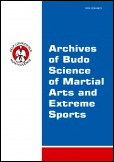2021, Volume 17, Issue 1
Mobility of thoracic spine and flexibility of the spine in relation to the size of the anteroposterior curvatures in school children
Piotr Kurzeja1
1Health Institute, Podhale State College of Applied Sciences in Nowy Targ, Nowy Targ, Poland
Author for correspondence: Piotr Kurzeja; Health Institute, Podhale State College of Applied Sciences in Nowy Targ, Nowy Targ, Poland; email: piotr.kurzeja@ppuz.edu.pl
Full text
Abstract
Background & Study Aim: A correct body posture is one of the factors necessary for harmonious functioning of the human body. However, a significant part of youth and children's population have postural defects, interfering with their proper physical development. Joint mobility, particularly within the spine, is one of basic functions in general evaluation of motor apparatus in men. The aim of this study was knowledge of selected indicators defining to the size of the anteroposterior curvatures and mobility of thoracic spine in school children.
Material & Methods: The study was conducted in a group of 61 school children. Was used for the study Otta and Thomayer tests and a computer set to evaluate the subjects' body posture. The results were analysed using adequate statistic methods.
Results: The results obtained were statistically significant as for thoracic spine flexion. Higher values of thoracic kyphosis indicators were found in patients with abnormal mobility of the thoracic spine. The range of spinal mobility was greater in people with less thoracic kyphosis. The correlation analysis in the study group showed a moderate negative correlation between the values of the thoracic kyphosis angle indices and the mobility of the thoracic spine and its suppleness.
Conclusions: In the study group of children, changes in selected functional indicators of body posture were observed. The anterior-posterior curvature of the spine can affect the mobility of the spine.
Key words: photogrammetric method, sagittal plane, spine mobility





